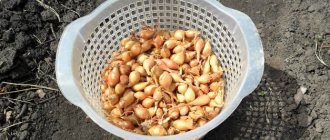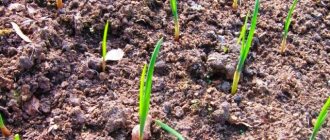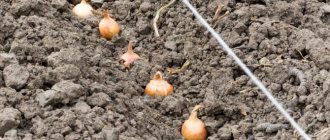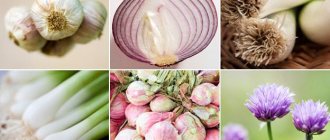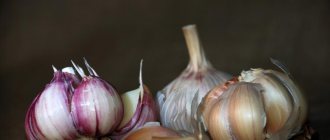Popular and beloved by many, garlic has been known to mankind for more than six thousand years. It is widely used in cooking; the cuisines of many peoples of the world cannot be imagined without this vegetable. Due to its strong phytoncidal and antihistamine properties, it is actively used in medicine, both traditional and folk. In a number of national cultures, mystical properties are also attributed to it.
This vegetable is grown everywhere; the cold-resistant plant has zoned varieties for all regions of the country.
Planting garlic is possible both in spring (spring garlic) and in autumn (winter garlic). The harvest of garlic planted before winter ripens 2-4 weeks earlier, the bulbs grow larger, but are poorly stored. Spring garlic is not characterized by high yield; its readiness comes later, but it is suitable for long-term storage, up to a year and a half.
What varieties of garlic are suitable for planting in Siberia?
Garlic is found in almost every summer cottage. The vegetable is very popular among Siberian summer residents. To reap large harvests, you should plant not only in the spring, but also before winter before the onset of cold weather, but also when the heat has already subsided, that is, in the fall. It is also very important to choose the right variety.
Siberia stands out among other regions for its extremely harsh weather conditions.
Therefore, many varieties simply do not have time to ripen. To harvest a large garlic harvest, you need to plant before winter and select a suitable winter comb. For Siberia, the following winter varieties can be used:
- Gribovsky Yubileiny . The variety is characterized by good yield and early ripening. The heads are large with high taste characteristics;
- Sofievsky . This variety of garlic is not susceptible to frost. You can plant in winter. The heads are large and rarely susceptible to fungal diseases. Painted white with purple stripes;
- Alcor . It is a mid-season winter crop and produces a harvest 85 days after planting. A special feature of the variety is immunity to fungal infections;
- Lyubasha . A winter variety popular among summer residents. It is highly resistant to fungal infections. It tolerates frost well and produces large yields.
ON A NOTE. The varieties that can be planted in Siberia before winter are characterized by frost resistance and undemanding care. A wide variety of varieties of winter garlic allows you to choose a high-yielding variety.
Yield varieties for winter plantings
The Siberian region is dominated by non-chernozems, sod-podzolic soils, taiga, sod-forest, taiga-permafrost soils. In such conditions, in order to plant garlic in the fall, vegetable varieties are selected with high resistance to cold and disease:
- If it is necessary to grow a bolting species, choose the “Siberian” variety, which is considered one of the most popular. The bulbs are rounded-flat, slightly pointed towards the top, each weight is from 19 to 28 g. The outer scales are colored grayish-violet. Mid-season "Siberian" germinates in March. There are about 4 small pinkish-purple cloves in the bulb.
- The non-shooting species “Novosibirsky 1” is characterized by high winter hardiness. To know when to harvest Novosibirsky 1, it is necessary to take into account the ripening time. Approximately 75 days pass from planting to harvest. The shape of the 19 gram bulbs is slightly rounded, the dry scales are pale pink. There are 10 cloves, each weighing approximately 2.5 g. The taste is semi-sharp. They get a yield of 1.04 kg per m2. A distinctive feature of “Novosibirsk 1” is the resistance of the bulbs to fusarium.
- The “Alcor” variety, which has a peninsular, semi-sharp taste, is considered a winter variety, with medium ripeness, and high yield. Alcor is grown both in small beds and on an industrial scale. The harvest is stable. On one hectare it grows up to 3.6 tons. The bulbs are very large, each weighing from 36 g. There are 5 teeth, resistant to diseases. Keeping quality is very good.
- A popular Siberian variety is “Skif”. Vegetables of medium ripeness ripen from the moment of planting in 95 days. Flat-round bulbs with white-lilac scales are dense, weighing 29 g. Up to 0.8 kg is collected from one m2. "Skif" is resistant to white rot and bacteriosis. The taste is spicy.
- The winter variety "Sir-10" is considered mid-season. Large bulbs have a flat-round shape. Heads with 9 teeth weigh 30 g. The density is average. "Sir-10" is resistant to diseases, with a high degree of winter hardiness. Widely used for preservation. The growing season is 87 days. A distinctive feature is that it is poorly susceptible to bacterial rot. 0.43 kg is collected from one m2. The pulp is dense, the taste is quite sharp.
- The “Autumn” type is considered universal. Large, dense bulbs weigh from 37 to 41 g. White dry scales have a lilac or purple tint. There are 4 or more cloves with creamy, juicy pulp. The vegetables are early ripening, bolting, winter-hardy, and high-yielding. They are used for crops in the Siberian region, when it is advisable to harvest winter crops at the very beginning of the summer season.
- The species “Bashkirsky 85” is considered early ripening. Technical ripeness occurs approximately 90 days after germination. The flat-rounded bulbs are considered large, since the weight of each reaches up to 60 or 70 g. The juicy, sharp-tasting appearance is resistant to diseases, often grown on an industrial scale, its yield per hectare is about 7 tons.
- It is worth paying attention to the winter-hardy “Grodekovsky”. Although it is not very large, the bulbs weigh 14 g, but it has a good yield (3 tons per 1 ha), and the growing season is about 85 days.
The “Reliable” variety is a shooter, tolerates cold well, is considered universal, and has an average degree of ripening. Large bulbs weigh 70 g each. “Reliable” is distinguished by its high shelf life and can be stored after harvesting for up to 11 months.
To know when to harvest a particular variety and to achieve a high quality harvest, it is necessary to adhere to agricultural techniques for growing vegetables.
How to choose the right time to plant garlic in Siberia?
Planting before winter should be done in the first half of autumn. The most optimal period is September and October. Some summer residents manage to plant garlic cloves in the second half of autumn and even in November, however, the survival rate of the crop is only 40%.
But planting in early autumn allows the garlic to properly form a root system and wait out the winter well.
Signs associated with the time of planting garlic
There are various myths, legends, rituals and signs associated with the magical properties of this spicy vegetable.
Garlic should be planted:
1. When the birds fly south.
2. When the leaves fall on the trees.
3. Until the Intercession of the Most Holy Theotokos (October 14).
4. On the waning moon. It is better to plant garlic when the moon is waning - the plants will germinate quickly, suffer less pain and ultimately produce a large number of bulbs.
However, global warming also adjusts the folk calendar, so it is better to look at the weather and move the planting date from autumn to winter closer to the real cold.
When to plant garlic in 2022 in Siberia before winter according to the lunar calendar?
The lunar calendar is an assistant for every summer resident.
Using the lunar calendar, you can choose the most optimal time for planting winter garlic.
So, it is advisable to plant winter varieties of garlic in the first two autumn months.
NOTE! It is not recommended to plant winter garlic in August. The teeth quickly form young shoots, which are damaged at the first frost.
Favorable days for planting garlic in 2022 in Siberia in the fall before winter?
If it is difficult to determine when to plant a crop in the fall, it is recommended to use the advice of the lunar calendar. The following numbers are considered the most suitable for planting:
- September – 1, 2, 3, 24, 25, 26, 27, 29, 30;
- October – 3, 4, 21, 22, 24, 25, 26, 27, 31.
It is believed that planting on these dates allows you to grow a large harvest and make the crop stronger and more resilient.
Unfavorable days for planting garlic in Siberia in 2022 in the fall
In addition to positive numbers that can be used for planting winter garlic in the fall, unfavorable ones must be highlighted. These include:
- September – 4, 5, 6, 7, 8, 9, 10, 11, 14, 21, 22;
- October – 1, 2, 5, 6, 12, 13, 14, 20, 29.
However, each summer resident independently selects the most suitable period for planting winter crops. If for some reason timely planting does not take place, it is permissible to plant the crop on unfavorable dates.
Benefits of autumn planting
Growing winter garlic in Siberia requires a long dormant period of 4-6 months. Even at sub-zero temperatures, the culture takes root. Autumn planting of winter varieties of garlic has many advantages:
- The heads grow large and dense.
- The growing season of the vegetable is reduced. With the arrival of warmth, it begins to grow immediately. Even in cold spring, garlic growth does not stop. Therefore, the harvest is dug up 25-40 days earlier - already in early June.
- You can get a double harvest from one plot by planting another crop after harvesting winter garlic.
- Planting material can be placed in 2 tiers, which saves space in the garden.
- There will be no need to waste time planting garlic in the spring.
The disadvantage of winter planting is the risk of freezing and rotting of the cloves. To protect the plantings from severe frosts, you have to mulch them and sprinkle them with a thick layer of snow. In addition, it is advisable to plant winter varieties adapted for growing in Siberia. Another disadvantage is that the shelf life of such garlic is shorter than that of spring subspecies, which are planted in the spring.
On a note! A characteristic feature of winter garlic, suitable for autumn planting, is large and approximately identical cloves. They are held in 4-8 pieces on the central stem. In spring species, small and numerous denticles are arranged in a spiral.
How to prepare a garden bed for planting garlic in Siberia?
It is recommended, first of all, to carefully prepare the bed for planting. And only after that begin planting work.
You should start preparing the beds before the beginning of autumn. Site preparation consists of the following steps:
- in the selected area it is necessary to remove all weeds and break up earthen piles;
- dig the ground deeply;
- level with a rake and apply complex mineral fertilizers;
- add humus (10 kg of fertilizer is used per 1 m2);
- Water thoroughly and leave for 3-4 weeks.
Before planting garlic cloves in the fall, you need to loosen the soil a little and only then plant.
NOTE! Before planting a crop, it is important to carefully read the forecast for the expected planting days and only then plan agricultural work.
In addition, the right location is of great importance. Winter garlic should be planted on level areas. Planting is not carried out in hollows, since stagnation of melt water can cause rotting.
It is also not recommended to form beds on a hill. This risks the wind blowing away the shelter and causing the garlic beds to freeze.
Selection and preparation of a place for planting winter garlic
Garlic prefers soils that are well fertilized for its predecessor, accessible to the sun, relatively light, with a neutral or slightly acidic reaction. The crop is demanding on the presence of nitrogen in the soil, however, applying fresh manure before planting is unacceptable, as this leads to increased bolting of the plant and a decrease in its resistance to diseases.
Photo. Garlic bed
The best predecessors of winter garlic are crops for which the soil was richly fertilized - zucchini, cucumbers, early cabbage. It is unfavorable to place the crop after tomatoes and potatoes due to the likelihood of damage by fusarium and nematodes. Just like after onions, in crop rotation garlic is returned to the same bed after 3-4 years.
If the soil is heavy, when preparing it it is useful to additionally add mature compost, humus, and sand to the bed.
How to prepare planting material for planting in Siberia?
Before planting winter garlic in the fall in Siberia, you should properly prepare the planting cloves. The preparation process is as follows:
- All garlic cloves must be carefully inspected and damaged and rotten ones must be removed;
- all specimens that have a damaged shell must be set aside;
- Place all the cloves in a deep container and fill with saline solution. For every liter of water use 2 tablespoons of salt. Leave for half an hour and dry thoroughly. You can replace such a solution with a light solution of potassium permanganate;
- dry the teeth and plant.
Without preparation, planting material may not survive the winter well. Winter garlic is often damaged by bacterial diseases. Winter garlic is also often damaged by pests.
All this leads to the fact that the crop does not sprout in spring.
Preparation of planting material
The choice of good seedlings plays an important role in obtaining a good harvest. The plant reproduces by cloves or bulbs. The larger the planted cloves, the better the harvest. Planting with whole heads improves the health of the planting material, so it is recommended to alternate planting with cloves and heads annually.
The heads are divided into cloves immediately before planting. There should be a piece of heel on each tooth. To disinfect the seed, it is immersed in a saline or alkaline solution for 2 hours. The saline solution is prepared by adding 3 tbsp to 5 liters of water. l. salt. To make an alkaline solution, dilute 0.5 kg of wood ash in 2 liters of water and boil for 30 minutes.
It is very important to ensure that there are no pieces of the mother bulb on the cloves before planting. A dry, hard bottom will prevent the passage of moisture and rooting. Before planting, the cloves are sorted by size. Only the outer teeth are suitable for planting, while the inner ones are used for food. The standard number of cloves planted is 40-50 pcs. per 1 m2.
After what can you plant garlic, suitable predecessors?
In order for winter garlic to produce a large harvest, it is important to observe crop rotation on the site. The most suitable predecessors are the following cultivated plants:
- cucumbers;
- pepper;
- eggplant;
- pumpkin;
- zucchini;
- peas.
All of them have a short ripening period. Therefore, by autumn the bed will be ready for further use.
NOTE! If onions or garlic were previously grown on the site, there is no need to replant. The soil is in a state of starvation and yields are declining.
How to choose a place and prepare a bed for winter garlic
Garlic has a short root system. Therefore, it does well after plants with long roots. The pungent root vegetable requires loose and moist soil, with normal or low acidity. Now, how to prepare a bed for garlic for planting in the fall.
It is best to choose a place for the garden bed on the sunny side and place it from north to south.
To prepare a bed for planting winter garlic, you should go through several steps:
- We fertilize
- Forming
- We give it time to settle,
- Processing
- We fertilize.
1. Already at the end of August - in the first ten days of September we begin to prepare the soil - we fertilize. We prepare and apply organic-mineral fertilizer, which consists of:
- Chalk - glass,
- Ash - 2 cups,
- Superphosphate - a tablespoon,
- Potassium sulfate – 2 tablespoons,
- Humus – 10 kg.
This amount is calculated per 1 square meter. After applying fertilizer, the bed must be dug up to the depth of a spade bayonet - at least 20 cm.
Note: You cannot plant garlic immediately after digging the bed. When the soil settles, the cloves will “go deep” - it will be more difficult and longer for them to break through, resulting in a decrease in yield. And you don’t need to press it - just put it in the hole and sprinkle it.
You can not fertilize the soil at all before planting, but do it in the spring.
2. The bed is formed at the rate of no more than a meter in width and up to 25 cm in height.
3. Then they do nothing with the bed - they leave it to settle. To make this happen a little faster, the bed is watered several times.
4. To protect plants from diseases, the soil is treated with a solution of 1% copper sulfate (dilute a tablespoon of copper sulfate in 10 liters of water). A bucket of this solution is enough for a couple of square meters - water it with a watering can. Afterwards it is advisable to cover it with film.
5. Before planting, you need to scatter urea over the garden bed (a tablespoon per square meter) and water it.
Useful: For warmth and protection from snow, you can lay spruce or pine paws on the beds.
What to put in the hole when planting garlic in Siberia before winter in the fall?
When planting winter garlic, it is very important not to delay the procedure, since late planting can lead to the death of the vegetable.
To make the planted cloves better accepted, you can add fertilizer when planting.
It is recommended to put a little wood ash in the hole. It will protect garlic cloves from fungal infections and increase yield.
Differences between spring garlic and winter garlic
There are several significant differences between spring garlic and winter garlic:
- Winter garlic is larger and consists of 4-10 large cloves arranged around a thick stem. The spring onion contains many segments of different sizes, arranged in a spiral.
- Spring garlic (except for the Gulliver variety) does not form shoots with airy bulbs. Therefore, it is propagated only by cloves. Winter varieties usually bolt and can be propagated by growing from bulbs.
- The spring crop lasts longer and remains viable for up to 2 years.
How to properly plant garlic before winter in Siberia, planting schemes
It is recommended to plant winter garlic in September and October in Siberia according to the following schemes, the most common of which is considered to be the following:
- select teeth of the same size;
- make furrows, the distance between which is at least 20 cm;
- plant garlic cloves at a distance of 15 cm from each other;
- sprinkle with soil.
If you use material of different sizes, you can use the following scheme:
- It is necessary to make identical furrows on the prepared area;
- plant a row of large cloves, then a row of small cloves;
- Maintain no more than 10 cm between small teeth.
It is recommended to carry out planting work before winter on a fine sunny day. After planting, the area should be thoroughly watered.
Landing
I am devoted to the Gribovsky Jubilee variety. This is a large purple head with very large teeth. There are only 6-8 of them, less often 10. In principle, for planting you need to take only the outer cloves, but in this variety there are almost no internal ones.
* By the way, the varieties “Sbirsky”, “Novosibirsky”, “SIR-10” are also excellent for growing in Siberia.
Before starting planting, I fill the teeth with a dark crimson solution of potassium permanganate for 40 minutes.
Planting pattern: 20 cm row spacing and 12-15 cm in a row. My beds are not wide, about 80-90 cm. They are easier to care for. Thus, you get 4 rows of garlic with a distance of 10-15 cm from the edge.
I plant as follows: I either stretch the twine on two pegs, or I put a light long glazing bead (slat) so that the rows are even. Then I take one clove from a jar of potassium permanganate, and bury it bottom down with three fingers until the surface of the soil is at palm level (about 4-5 cm). I planted about 8 of them, leveled the holes, patted them with my palm and continued. If you pull two twines, then things will go faster.
When both beds are planted, I mulch them with a small layer of humus or compost soil (about 2 cm). No watering required. Spent 1 hour.
In young strawberry plantings, I plant garlic in one row in the center; I don’t fertilize it with anything in advance, since the beds were thoroughly prepared for the berries in July, but I do mulch them with humus. That's it, you can forget about garlic until spring. Snow will fall soon (50-70 cm) and he will be warm.
How to plant winter garlic from bulbs?
One of the methods for propagating winter garlic in the fall is aerial bulbs. Planting such material is very simple, just follow simple tips:
- in mid-summer, collect airy bulbs that are already fully ripe;
- prepare the area in the fall and make longitudinal furrows;
- sow seeds at a distance of at least 5 cm from each other;
- Young shoots will appear in early spring.
Using air bulbs, it is impossible to get a harvest in the first year. After sowing in the first year, small heads appear that can be planted and left for another year. Two-year-old garlic is distinguished by its large size and high taste properties.
The best varieties of winter garlic for Siberia
When choosing a variety of winter garlic, you should take into account that it adapts for a long time to changing growing conditions, which can cause a loss of varietal qualities and a decrease in yield, and therefore the choice should be made on zoned varieties. The most popular in the Non-Black Earth Region are the bolting Siberian and non-shooting Novosibirsk 1, which are characterized by high winter hardiness and resistance to diseases.
Harvest variety of garlic
The following varieties can also be recommended for winter cultivation in Siberia:
- Alcor;
- SIR-10;
- Scythian;
- Autumn;
- Bashkirsky 85;
- Reliable.
Gardening Tips and Tricks
It is necessary to plant winter garlic in Siberia, observing all agrotechnical rules. However, following the advice of experts is also of great importance for successful cultivation:
- It is necessary to plant winter crops in loose soil so that the teeth do not rot;
- After the material is planted, watering should be small. Heavy moisture leads to rot;
- to ensure that the bulbs are not damaged during the winter, they must be treated with a strong solution of potassium permanganate before planting;
- One variety must be planted on the site. If several winter varieties are used, it is recommended to maintain a distance of at least 50 cm between them.
Simple tips allow you to get not only a large harvest, but also improve the taste of garlic heads. All tips have been repeatedly tested by summer residents and proven to be effective.
Care rules and useful tips
They begin caring for winter garlic beds with the arrival of spring. It includes the following activities:
- When the snow melts and the soil dries out, the beds are loosened to a depth of no more than 3 cm.
- Add a fresh layer of mulch on top to retain moisture.
- Plantings are watered in May and June, usually once a week. When it is hot and there is no precipitation, the soil is moistened more often - 2 times every 7 days.
- Remove weeds regularly.
- Fertilizers are applied 3 times per season. The plants are fed for the first time when 2 true leaves are formed. Urea is used to stimulate growth. The solution is prepared in the proportion of 1 tbsp. for 10 liters of water. After 2 weeks of planting, they are fed a second time with nitroammophoska at a dosage of 2 tbsp. dry matter per bucket of water. During active growth of the bulbs, add superphosphate, diluted at the rate of 2 tbsp. for 10 liters of liquid.
Important! 3 weeks before digging the bulbs, it is necessary to stop watering to avoid “wateriness” of the cloves.
You can get a good garlic harvest if you follow the recommendations of agronomists:
- To increase the amount of planting material, one-toothed bulbs formed from air bulbs are used.
- Deep planting will protect winter garlic from freezing. Small cloves are buried into the soil by 4-5 cm, and large ones by 5-7 cm.
- Wood ash will help reduce soil acidity. It is added when digging the site.
- The larger the clove, the larger the onion will be.
- The arrows must be broken off immediately so that the plants do not waste energy on forming inflorescences. They are left if “seeds” – bulbs – are needed.
Winter garlic is unpretentious and gives a good harvest if you adhere to cultivation techniques. It is important not to allow the soil to become waterlogged so that the bulbs are not affected by fungus. When choosing planting dates in 2022, it is advisable to adhere to favorable days of the Lunar calendar for garlic. It is important to take into account the climate of the region, since the culture takes time to take root. In Siberia, it is recommended to grow zoned varieties that are resistant to frost.
Common mistakes
When planting winter garlic in Siberia, many summer residents make mistakes that can have a detrimental effect on the yield. Among the most common it is necessary to highlight:
- use of manure. When planting winter garlic, manure is often used as fertilizer. However, such organic fertilizer can lead to burns and death of planting material;
- landing in lowlands. In such places, melt water can accumulate, which causes rotting;
- too early disembarkation. If you plant a crop too early in the fall, it will begin to form young shoots and may die under the influence of frost;
- use of fertilizers in large quantities. Overfed garlic rots, and weak, light green sprouts appear in the spring.
When planting winter garlic, you need to avoid mistakes that can have a detrimental effect not only on yield, but also on taste.
Care
Care is a very important point. To get a good harvest, you need to provide the plants with good care. If you live in a region with snowy winters, mulching the soil is not necessary at all. During the winter, you need to check whether the crops are well covered. If necessary, cover them additionally:
- sprinkle with last year's leaves;
- cover it with snow.
The first shoots of winter garlic appear in the spring, when the snow has not yet melted. The sprouts are pink-violet. While the soil has not yet warmed up, in the spring, it is fertilized with a nitrogenous solution. For 1 m2 you will need 1 tsp. urea.
Throughout the summer you need to loosen the soil and remove weeds. This will ensure optimal soil aeration. Garlic is a moisture-loving plant, so after the first shoots appear, the plantings are watered 3-4 times with an interval of 10-15 days for 1.5 months. Watering abundantly, water is poured into the row spacing. Then water the plants as needed.
After each watering and precipitation, you need to loosen the soil. This prevents the formation of a hard crust. Arrowing varieties shoot arrows in June. If the vegetable is grown for the purpose of collecting planting material for the next year, they are left until fully ripe; if not, they are removed. Removing shoots allows you to increase the weight of root crops by 40%.
Answers to frequently asked questions
Is it possible to plant seedlings without processing?
It is possible to carry out such a landing. However, in this case there is a risk that the planting material will be damaged by pests. In early spring, untreated sprouts are often susceptible to fungal infections.
Is it possible to plant garlic in frozen ground?
Planting in frozen ground is not recommended. This will lead to the death of the planting material.
Planting garlic bulbs for the winter
The aerial bulbs are disassembled into cloves. Before planting, soak in water for several days. The floating seeds are discarded.
Just like for planting with cloves, prepare the soil a month before planting. The planting pattern is the same, but with a difference in the size of the hole and the recess, they are smaller (this is understandable - the airier cloves are smaller than usual).
Plant garlic in bulbs in holes with a diameter of 3-5 cm, at the same depth of 3-5 cm at a distance of 5 cm. The spacing of the rows is 20 cm.
Next, sprinkle with earth and cover with mulch.
Sowing garlic in the ground, greenhouse in March, April, May, August, June, September and October
Garlic cannot be treated without due respect and special sympathy, because it is not only an important, tasty and useful vegetable for cooking, but also a healing one, with the help of which we can get rid of many ailments, but this, as they say, is a topic for another conversation.
Summer residents of Irkutsk are interested in the lunar calendar of sowing and planting days for spring, summer, and also winter garlic in the fall in 2020, planting in the ground and greenhouse at those safe sowing and planting dates, and for the entire summer season, thanks to which they calculate and with the help of the information offered in the table, achieve high yields of this and other crops.
Garlic for summer residents and gardeners of Irkutsk, as well as for anyone else who grows this healthy and appetizing vegetable, is also a miraculous product with which you can prepare a number of effective, preventive and medicinal preparations. Garlic will help not only in culinary matters, where it is used very widely, and in many dishes it is simply irreplaceable, but it will also lower our blood pressure, have a beneficial effect on our circulatory system, and it is also useful in other matters that you can find out about on the Internet.
The lunar calendar for sowing and planting garlic in Irkutsk will tell you when it is favorable to sow and plant in spring, summer and autumn for the winter of 2020, to plant in a greenhouse and in the ground, on which days it is safe and will be conducive to establishment, further growth and development, because as we know agricultural crops require attention, which means that by showing it, we will increase our chances of ultimate success in achieving higher yields of this vegetable.
Sowing and planting work for the domestic summer resident in spring and summer, this is probably on par with the choice of preparatory work for sowing seeds and planting seedlings, planting plants, are the main, most responsible and fundamental in any summer season, regardless of what crop, tree, shrubs or flowers and in what month gardeners, gardeners and flower growers plant them, in what exact place.
It is important to take planting and sowing activities seriously, and gardeners, gardeners and flower growers are well aware of this. It is the choice of planting for a particular crop that can play a decisive role in the acceptance of this plant, its establishment, growth and further development. As you know, the season for summer residents, gardeners, gardeners and flower growers never ends, it is a year-round cycle and continues constantly.
The concerns of those summer residents who grow some kind of agricultural crops, the same flowers, plants, vegetables and fruits, including garlic, are always in sufficient quantity and they constantly monitor those that they have bred and grown at home, in a greenhouse or on a dacha, personal plot or some other plot of land.
In Irkutsk, planting garlic must be carried out on favorable days according to the lunar calendar of 2022, when it is most safe to sow and plant garlic, summer or winter for the winter, and vice versa, seeds, seedlings or plants planted on the right day will have a greater likelihood that their development will be prosperous and successful.
